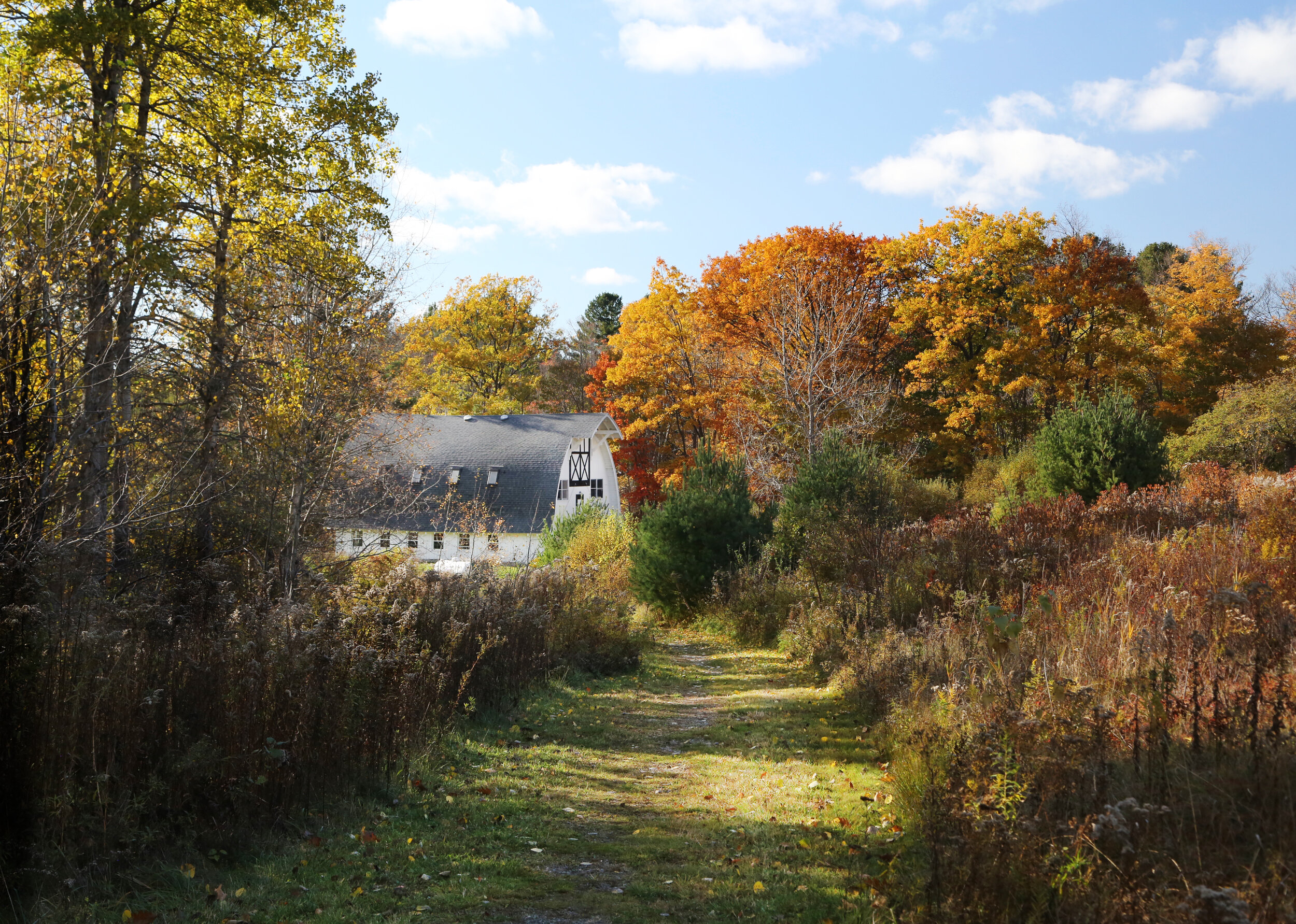Advice
What’s the Deal with Writing Residencies?
The Blunt Instrument on the ins and outs of residencies for authors

The Blunt Instrument is a semi-regular advice column for writers. If you need tough advice for a writing problem, send your question to blunt@electricliterature.com.
Dear Blunt Instrument,
I’m a contributing writer at Electric Literature. I was discussing writer residencies with some of the EL editors and we thought it might be a good topic for your column. Basically, as a writer, I feel like everyone I know is doing them, but I’m not sure what value they provide, i.e. is it just a good, free place to write? Are they valuable for your resume? Also as someone who works in NYC, it’s difficult to take off, so how do people navigate that issue?
Cheers
This is a great topic, but having never done a writing residency myself, I didn’t feel qualified to answer your questions. Instead, I spoke with author Sandra Beasley, who is much more versed in this area than I am.
Sandra Beasley is author of three poetry collections: Count the Waves; I Was the Jukebox, winner of the Barnard Women Poets Prize; and Theories of Falling, winner of the New Issues Poetry Prize, as well as the memoir Don’t Kill the Birthday Girl: Tales from an Allergic Life. Honors for her work include a 2015 NEA Literature Fellowship, the Center for Book Arts Chapbook Prize, and three DC Commission on the Arts and Humanities Artist Fellowships. She lives in Washington, D.C., and is on the faculty of the low-residency MFA program at the University of Tampa. You can find out more by visiting SandraBeasley.com
The following interview took place over email in February of 2017.
You’re someone who has done multiple writing residencies. How did you get started? What was your first residency experience like?
I’m writing this for you while at the Hermitage Artist Retreat in Florida. I’ve been up since 3 AM. The beach of Manasota Key is a hundred feet to one side of my bedroom; the bay is fifty feet to the other side. My fellow residents, housed in four adjacent forms of housing, are a drummer, a novelist, a composer, and two photographers, though by next week the mix will be different. I’ll be here through March, working primarily on nonfiction. The last time I was here, I had to keep my curtains tightly closed at night lest the light from my reading lamp lure baby sea turtles in the wrong direction.
One funny thing about being a writer on the road is that a few years in, you forget what it’s like to travel without an anchoring reading, or a classroom visit, or a concentrated opportunity to write. Traditional vacations lose their appeal. If I can spend 3–4 weeks at a residency each year for the rest of my life, I will, with the occasional exception to prioritize a getaway with my husband.
How did I get here? I graduated from the University of Virginia in the spring of 2002. By that fall, I was working full-time at a nonprofit simultaneous to earning my MFA from American University, where I also served on the editorial staff of their literary journal. I had a partial fellowship, but I also had loans and a lot of pressure on my shoulders. Applying for residencies was a way of pushing back on all of that. I’ve never been good at creating boundaries. I say Yes to things more than I should. I suspected that those who’d gotten used to siphoning off my time would respect the formality of a residency, and that hunch proved correct.
My first residency was in June of 2003, at Vermont Studio Center. That’s an expensive one, though I didn’t have any reference point. I thought of it as budgeting for a vacation, and in a way I was. You stay in beautiful buildings along the Gihon River. The residency carries an opportunity to conference with a visiting Master Artist, which in my case was poet Carol Moldaw, who was generous in her feedback. The Red Mill’s community library is particularly rich. I fell so hard for Karen Chase’s collection Kazimierz Square that I stole VSC’s copy.

Jeez, my heart leaps, remembering. We’d go to a nearby watering hole and pick off baby leeches afterwards. I bought a 99-cent bottle of Miracle Bubble and walked down the stretch of highway that is Johnson’s main drag, blowing bubbles at the passing truckers; I took a lot of photos with my last proper film camera, an Olympus with a panoramic option. The visual artists threw the good parties. Eight of us would drag a couch out into the gravel parking lot, turn up the volume on Louis Armstrong and His Hot Five, and stand around talking and drinking into the early hours. At age 23, this was heaven.
What value do residencies offer for writers? Is it mainly a way to get time and space to write? Or are they also important for resume-building, industry networking, getting an agent, getting a job?
The value of residencies is the work you do while you’re there, with social networking as an option. What you do is really and truly up to you. One of my favorite things I ever heard was said on my first day at Millay: “You’re here to honor yourself as a writer,” the residency director said while giving the tour. “If that means reading, rather than writing, that’s fine by us.” I found that really liberating — and of course, once I felt free to do what I craved, which was curl up on the studio couch with a handful of poetry collections, I was inspired to write.
Different residency spaces, and how long you have in them, shape the work that will get done. A brief stay might be best for editing an existing story or essay. A studio with pegboard walls and lots of floor space is perfect for laying out pages that need to be ordered for a poetry manuscript. A desk next to a big window might inspire new drafts, while an Adirondack chair beside a river might become a favorite reading spot. I make a conscious effort to take cues from the setting.
I’m always subconsciously looking for excuses to not write, and I don’t want the landscape to be one of them.
Personally, my ideal setting is “pretty but not too exotic.” I’m always subconsciously looking for excuses to not write, and I don’t want the landscape to be one of them. Many of the spaces that become residencies have fascinating back-stories. On the grounds of Millay you can still see the ghost-outline of poet Edna St. Vincent Millay’s tennis court, and track down her repository field of empty gin bottles. The Hermitage was a nudist colony at one point.
As an added line to a resume or curriculum vitae, attending a residency won’t make a big difference. But most gatekeepers, by whom I might mean a prospective agent or someone interviewing you for a teaching job or fellowship, are members of the literary world themselves. If you can deepen your connection with them based on shared familiarity with a residency — Yaddo and MacDowell are known to have the power to do this — that can help.
The Blunt Instrument on Dealing with Rejection & the Anxiety of Publishing
How do you stay productive? How do you structure your time?
I love lists, so I usually end up making three lists on arrival. The first captures the elements of an ideal residency day, meaning the balance of reading, writing, and physical activity I need to feel rested and refreshed. I don’t make a to-do list of the actual residency work, or the order in which it needs to happen; that would make me claustrophobic. The second list gathers and, I hope, compartmentalizes the practical tasks that tie me to life back home, such as getting a student recommendation letter in or returning proofs on a freelance piece. The third list is a holding pen for fun stuff I hear about from other residents — “Oh, you have to check out that barbecue joint” — or destinations I identify when researching the area, such as a nearby Botanical Gardens or independent bookstore. I usually drive, which gives me the freedom of taking a few hours off and exploring; sometimes a residency will have a loaner bike or car.
In terms of the social time, the intensity of that can vary. Some writers crave the spontaneity of field trips, parties, after-dinner conversations, and maybe a board game or round of ping-pong. These friendships tend to spark quickly, burn bright, and flicker out a month after the residency ends. Some writers seek out the same few people every lunch — they’re probably looking for a few takeaway friendships, or even relationships where you might later exchange work for critique. Some writers hide, period. Other writers want specifically to hang out with the artists and composers; their lives back at home are already well stocked with writer-types.
What’s the best way to find the right residency for you? Are there different residencies for different genres? Any specific recommendations for women, writers of color, writers with disabilities, chronic illnesses or other special needs?
There are lots of residencies out there. I mention Yaddo and MacDowell, but that’s like describing MFA programs in terms of the University of Iowa and NYU; just because they’re the famous ones doesn’t mean they represent the apex of this type of experience, much less the gestalt. Poets & Writers magazine has an annual issue devoted to residencies, as well as a database of conferences and residencies. Kim Roberts of Beltway Poetry Quarterly, in DC, curates an in-depth index of Artist Residency Programs that is sorted by type, geography, and genre, though most residencies welcome all genres of writing.
Increasing accessibility and inclusivity in the writing community, including residencies, is a much bigger conversation than we can have here. Here’s what I will say: if a program specifically solicits applications from a marginalized community of which you are a member, take a close look at why. Is it because their deep infrastructure is genuinely welcoming, and they want to get the word out to more people? If so, by all means give it a shot. A good example of this is a residency is fully outfitted with ADA-compliant design, often as a result of a specific donor gift.
Or…does this opportunity exist because your “kind” is not represented in their constituency, and they need you? If so, be aware that you might feel isolated or tokenized, and you’ll probably have to do some work of educating. Make sure your creative energy won’t be constrained by being an organization’s guinea pig, no matter how well intentioned they may be.
An alternative, if you have an existing literary community that is nourishing but lacks a “residency” outlet, is to create your own residency.
Residency time is precious and kind of fragile. An alternative, if you have an existing literary community that is nourishing but lacks a “residency” outlet, is to create your own residency. Reach out to that community with which you already gather for workshops or conferences, and see if anyone would be interested in splitting the cost of a short-term rental, where the specific purposes is unstructured and private writing space. There are retreats, such as The Porches in Virginia, which lend themselves to being occupied by self-made groups.
Also, remember that residencies evolve over time. One case study that comes to mind is Hedgebrook, on Whidbey Island in Washington state. They’ve been around since the late 1980s; I first looked at applying in the mid-2000s. At that time, Hedgebrook was a quirky option — you had to like rural cottage life — that happened to be exclusive to female applicants. The rumor was that they were open to emerging writers, meaning I had a viable chance at getting in.
I wanted to apply, but hesitated. I’d never dealt with my food allergies so far from home, not for a whole month. There was also a rule was if you got in, then couldn’t go, you forfeited future opportunity. This made sense from the perspective of a fledgling organization with minimal staff and limited resources. But it was scary for a twenty-something unable to guarantee, six months in advance, time off from work or funds for travel, which in my case would have been a very expensive cross-country plane ticket. So I went with another residency, on the East coast, which was the same size but was close enough that I could drive — saving money on travel, and ensuring access to a grocery store.
Today Hedgebrook has a prestigious and thriving alumni community, with associated salons and master classes and a slogan, “Women Authoring Change.” Deferrals are permitted, and they’ve modified their language to make clear that “women” welcomes those of trans- identity or other nontraditional gender expressions. They are clearer about how community meals are prepared; there’s even a Hedgebrook cookbook that emphasizes farm-to-table. There’s also a complicated process of deliberation, with three rounds of judging, and a narrow window for applying. I really want to attend, but I suspect I’ll have a tougher time getting in than if I’d applied in 2006. I wouldn’t worry at about the food now; still not sure how I’d pay for my airfare.
Can you do a residency if you have a full-time job?
You can definitely do a residency while in a full-time job. The terms of how long you can get away have to be negotiated with your employer, of course. [Ed. note: There is a real range of residency time periods, from as little as a week to up to 9 months. But even a week can be productive.] I notice that people whose workloads are cyclical — teachers, arts administrators, or those who work at nonprofits with a “slow” season — dominate the residency pool. If your job has no slow season, ask if you can have a specifically designated check-in day of each week, where you turn your studio into a virtual office and stay on top of critical responsibilities. You might pair that day with a day when residency life is typically interrupted anyway. Is every Wednesday night a showcase for resident works-in-progress? Cool. But if you work like I do, then you might as well set aside all of Wednesday the weekly errands, emails, and phone conferences.
You’ll want to scope out the tech resources in advance. Increasingly, residencies are wired for internet; some places provide WiFi in sleeping quarters, but not studios. A few places specifically resist such encroachments: Blue Mountain Center in New York doesn’t provide WiFi and cell phones are prohibited, except for emergency purposes. Jentel doesn’t have any such rule, but it is so far outside Sheridan that I remember having to stand on tiptoe at the top of a hill to get a Verizon signal. Also, know that printing and computer repair may not be as readily available as back home. Look for residencies that have a college campus nearby, as a back-up resource.
Any tips on applying to residencies? What to do and what not to do?
Submit the strongest possible work sample for two-thirds of the allotted pages. If your strongest work is completely different from the work you’re setting out to do, make sure that other third represents relevant material. That said, don’t worry too much about your project proposal. Everyone understands that a plan is theoretical, especially since months may pass between submitting an application and attending a residency. What evaluators are looking for is an ability to articulate goals, an ability to scale those goals specific to the time you’re requesting, and a connection to the particularities of their residency space.
What evaluators are looking for is an ability to articulate goals, an ability to scale those goals specific to the time you’re requesting, and a connection to the particularities of their residency space.
If you are required to send letters of recommendation, and you happen to know alumni of the residency, they are more compelling references than those of someone outside the community.
People will tell you to apply in a residency’s “off season” to increase your odds of admission; for example, they’ll suggest, apply for the upstate New England residency in a winter month. The accuracy of this tip probably varies, and administrators aren’t excited to answer queries about how to game the system. They’ll tell you to apply for when you genuinely want to attend.
Since we’re on the subject of how residencies are administered: if you get one of these opportunities, say thank you at every turn. Say thank you to the staff. Say thank you to the benefactors. If you publish a book that includes work you wrote while at the residency, mention them in the acknowledgements. Offer to write a letter of support for the residency’s future funding applications. Don’t take one minute of this for granted, especially in a moment when arts dollars are hard to come by.
Do residencies tend to be more social or more isolating? What happens if you’ve got family — can they ever come along or at least visit?
Whether a residency represents an opportunity to be social or isolated varies widely based on their circumstances, and yours. Larger residencies like UCross, Virginia Center for Creative Arts, and Vermont Studio Center do tend to have reputations as being “summer camp” for writers and artists, even when there’s snow on the ground. There is simple camaraderie in numbers: if you’re looking to take a break or open the wine, someone is always ready.
There are also residencies with service components, if you’re looking to be pulled out of your normal rhythms. In Tennessee, the Sundress Academy for the Arts asks residents to put in about five hours a week at Firefly Farms. Other residencies ask artists to visit local schools.
For me? I’ve lived in Washington, D.C. since 2002. I’ve got a very vibrant community that includes friends who go back to MFA days, an informal poetry workshop group, a book club of fellow women writers, and the Arts Club of Washington, where I volunteer my time. I love those folks but it makes for a very full calendar. At residencies I work in my room, for long and often late hours, and I skip group meals when I can. Not because I don’t like people, but I’m just so thrilled at the prospect of unfettered time.
Having family visit can be tricky. First off, it does happen. I’ve seen kids, parents, lovers, and spouses visit. Even though you may miss them like crazy and want them to see the residency, don’t underestimate the interruption that will occur — not only for you but for your fellow residency-mates — in terms of hours and focus of energy. That said, a day-trip visit is usually fun. An overnight will probably be okay, but will not be sanctioned; don’t expect the chef to make an extra serving of eggs for your partner in the morning. Any visit longer than that is usually overstepping your bounds.
There are a handful of residencies open to writers who need to travel with their families, and some provide stipends for childcare either on or offsite.
There are a handful of residencies open to writers who need to travel with their families, and some provide stipends for childcare either on or offsite. The Sustainable Arts Foundation is a key resource for writers with children. They recently gave New York’s Writers & Books a grant for programming co-situated between Neighborhood of the Arts, in urban Rochester, and the rural location of Gell: A Finger Lakes Creative Retreat. After choosing a location, artist-parents can be accompanied by their children and one other adult for a one-week stay. Applications are closed for 2017, but it’d be wonderful to see that become an ongoing program. The Hermitage welcomes artists with young children for one- or two-week stays in the month of June. The Island Hill House Artist Residency Program in Michigan gives the artist a whole house, which can sleep up to four.
Are there challenges to be aware of? Have you ever had a bad experience or totally blown the residency?
People in adjoined spaces get into thermostat wars. Bring a blanket and a fan so that you can self-regulate your temperature. While you’re at it, also pack an extension cord, noise-reducing headphones, and a flashlight. In residencies with buffet meals, people will complain about the cooking. In residencies with communal kitchens, people will complain about the housekeeping. Please, whatever you do, do not be that person who leaves dirty dishes in the sink. These are usually minor complaints in what everyone recognizes is an overall gift of a situation.
International residencies have their own risks. I’ve heard a few hair-raising stories about getting to an obscure city and discovering you’re someone’s B&B guest in a space with musty décor, dim light, and an uncomfortable chair. On the other hand, who isn’t tempted to take a chance on a castle? Luckily, word gets around fast if a residency is truly failing to thrive, especially in the age of social media.
More and more residencies are staggering the possibilities of arrival and departure dates. The model of being part of a curated “family” for exactly 28 days is becoming the exception, not the rule. That increases variety among those who can take part in a residency, which is wonderful, but be aware that your fresh start may be someone else’s or mid-residency crisis. When you sit down to lunch on your Day 1 and the composer across the table gives you a thousand-mile stare, it’s not about you; it’s about all he still wants to do in the three days before he leaves.
You’re walking in on other people’s romantic lives, too. People get divorced coming out of residencies. People get married coming out of residencies — I got lucky in that respect. My husband is a painter that I met at Virginia Center for Creative Arts back in 2012. We quickly realized we lived only blocks from each other, in northwest DC, which distinguished the relationship from a residency fling. There’s nothing wrong with residency flings, per se. Just be sure you don’t flirt around with the guy who was, prior to your arrival, romancing the woman who makes the service assignments for the residency. You’ll end up with two weeks’ kitchen duty, scrubbing sheet pans and cleaning bread mixers. Trust me.









